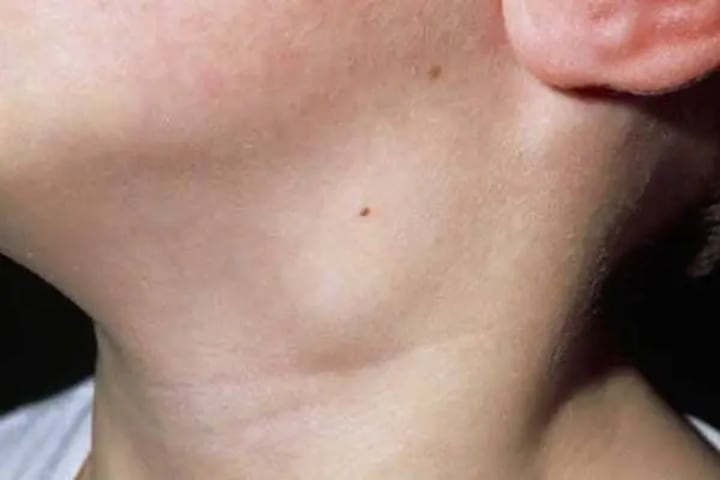How to distinguish benign or malignant lymph nodes?
Abnormally appearing lymph nodes can warn of cancer. How to know if a lymph node is benign or malignant?

Swollen lymph nodes are a sign that your immune system is fighting an infection or disease. Swollen lymph nodes are more likely to be benign than malignant.
Benign means the lymph nodes do not contain cancer cells. Malignant means they contain cancer cells.
1. What are lymph nodes?
The lymphatic system is part of the immune system. It is a network of lymph vessels and lymph nodes. There are about 800 lymph nodes scattered throughout your body, with more than a third located in the head and neck.
Lymph fluid, which contains white blood cells to fight infection, moves through lymph vessels. Lymph nodes act as filters for germs and foreign substances. When you have an infection, injury, or cancer, your lymph nodes swell as they filter out problematic substances.
When your lymph nodes swell, it can warn that your health is having problems.
So what causes swollen lymph nodes?
Swollen lymph nodes can be for many reasons, such as strep throat, an ear infection, or an immune system disease.
Cancer can also cause swollen lymph nodes. Lymphoma is a type of cancer that starts in the lymph nodes. But cancer cells can also spread from another part of the body to lymph nodes, often those closest to the primary tumor.

2. How to know whether a lymph node is benign or malignant?
To accurately distinguish whether a lymph node is benign or malignant, we cannot diagnose it by looking or feeling. But you can judge by some of the following signs:
- Signs of benign lymph nodes
+ Have other symptoms, such as cough, body aches or nausea - this may indicate a virus or other illness.
+ Swollen lymph nodes located near infected body parts, such as the throat, ears or mouth.
+ Swelling will gradually decrease as you recover from the infection or illness.
+ Usually small in size, when evaluated via ultrasound, lymph nodes smaller than 5 mm are benign.
+ Located in a clear area, moves with surrounding tissue when touched.
- Signs of potentially malignant lymph nodes
Lymph nodes always fight off "invaders", so a few cancer cells may not be enough to cause noticeable swelling. Signs that swollen lymph nodes should be checked by a doctor include:
+ No obvious disease or infection.
+ Fever and sweats at night
+ You have recovered but your lymph nodes remain tender or swollen for more than 2 weeks.
+ Lymph nodes become larger or harder and cannot move because they have invaded surrounding tissues.
The area around your lymph nodes is red, feels warm to the touch, or is leaking pus or other fluids.
+ Usually large in size, when evaluated via ultrasound, lymph nodes larger than 10mm are considered malignant.

3. How to diagnose whether lymph nodes are benign or malignant
To accurately diagnose benign or malignant lymph nodes, doctors need to perform tests such as:
- Diagnostic check
Diagnostic tests may include:
+ Blood tests to check for infection and underlying diseases
+ Imaging tests, such as X-rays, CT scans, MRIs or ultrasounds to get a better look at the lymph nodes.
- Biopsy
The only way to know for sure whether your lymph nodes are benign or malignant is to perform a lymph node biopsy. Your doctor may recommend this if:
+ Physical examination and diagnostic tests cannot determine the cause.
+ You have recently been treated for cancer or are currently undergoing treatment.
A biopsy involves taking tissue samples from lymph nodes. This can be done with a needle or the lymph nodes can be removed during surgery. The tissue samples will be sent to a laboratory, where a pathologist will use a microscope to look for cancer cells.
A biopsy often follows a cancer diagnosis, even if the lymph nodes appear normal.
4. How are benign lymph nodes treated?
Treatment depends on the cause. For example, your doctor may prescribe antibiotics to treat strep infections or antiviral medications for severe flu. If it is due to an immune disorder, you will need treatment for that specific condition.
Swollen lymph nodes caused by infection or illness will return to normal size as you recover. In the meantime, here are some other things you can do to reduce the discomfort caused by lymph nodes:
- Rest
- Drink a lot of water
- Apply warm compresses several times a day
- Avoid squeezing or poking swollen lymph nodes
- Take over-the-counter (OTC) pain relievers or anti-inflammatory drugs. However, you should talk to your doctor before giving OTC medications, especially aspirin, to a sick child.

You can use over-the-counter pain relievers if swollen lymph nodes cause pain 5. How are malignant lymph nodes treated?
If a biopsy confirms cancer cells in the lymph nodes, you may need further testing. That's because you'll want to know more about cancer and how it has spread. Lymph node involvement is a key factor in determining the stage and treatment of cancer.
Cancer that has spread from the original site to the lymph nodes means the risk of recurrence after surgery is higher. This means you may need additional treatment, such as:
- Valence
- Radiation
- Immunotherapy
- Targeted therapy
Removing lymph nodes can sometimes make it difficult for lymph fluid to drain properly, causing the fluid to flow backward. This condition is called lymphedema and can lead to noticeable swelling in the affected area. The more lymph nodes are removed, the more likely they are to become a problem. Lymphedema can become chronic.
In general, we cannot distinguish benign or malignant lymph nodes through common sense. However, you can rely on some other signs to be able to see a doctor promptly, detect abnormal signs and have appropriate treatment.
About the Creator
HK Decor
Telling stories my heart needs to tell <3 life is a journey, not a competition
If you like what you read, feel free to leave a tip,I would love some feedback
https://sites.google.com/view/hk-decor/trang-ch%E1%BB%A7
Enjoyed the story? Support the Creator.
Subscribe for free to receive all their stories in your feed. You could also pledge your support or give them a one-off tip, letting them know you appreciate their work.






Comments
There are no comments for this story
Be the first to respond and start the conversation.